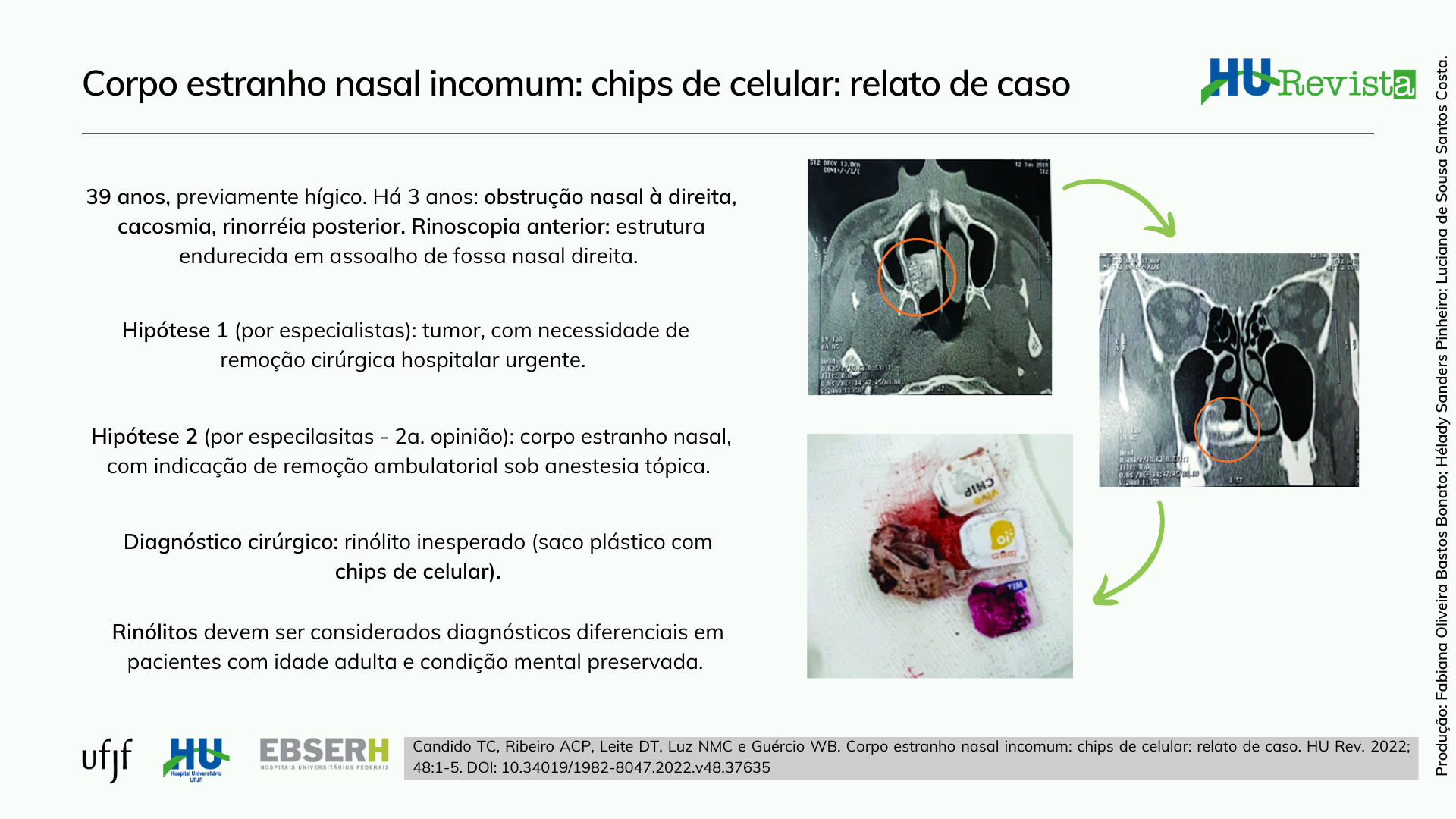Corpo estranho nasal incomum: chips de celular: relato de caso
DOI:
https://doi.org/10.34019/1982-8047.2022.v48.37635Palabras clave:
Doenças Nasais, Obstrução Nasal, Reação a Corpo EstranhoResumen
Introdução: Corpos estranhos nasais são motivos de assistência médica, seja em clínicas ou em serviços de emergência. A maioria dos corpos estranhos nasais ocorre em crianças e pacientes psiquiátricos. O diagnóstico é usualmente clínico. Se não forem removidos podem ser envolvidos por fosfato de magnésio, fosfato de cálcio ou carbonato de cálcio e, finalmente, tornarem-se estruturas endurecidas estáveis aderidas firmemente às paredes nasais denominadas rinólitos. Objetivo: Descrever um caso de paciente com rinólito nasal inusitado com diagnóstico prévio de neoplasia. Descrição do Caso: Este relato descreve um caso de um paciente de 39 anos que apresentava estrutura endurecida estável em assoalho de fossa nasal direita, de longa data de evolução. Paciente obteve consultas com especialistas cujo diagnóstico inicial foi de tumor com necessidade de remoção com urgência sendo assim encaminhado para o serviço público. Durante avaliação no setor de otorrinolaringologia o paciente foi submetido ao exame clínico, a tomografia computadorizada de seios paranasais e a vídeonasofibroscopia quando foi sugerida a possibilidade de corpo estranho nasal. Dessa forma o paciente foi conduzido para remoção em ambulatório sob anestesia tópica. Sendo revelado rinólito inesperado (saco plástico com chips de celular dentro). Conclusão: Apesar dos vários diagnósticos diferenciais possíveis, incluindo os de tumores, mesmo apesar do longo tempo de evolução, rinólitos não devem ser ignorados como hipóteses diagnósticas. Embora as características do paciente como idade adulta e condição mental preservada ou mesmo condições da localização não direcionem para tal suspeita, como no caso apresentado.
Descargas
Citas
Silva R, Costa VBS, Albuquerque AM. Primeiros socorros na retirada de corpos estranhos nos olhos, ouvido, nariz e garganta: revisão integrativa. Educ Ci Saúde.2017; 4(1):84-99.http://dx.doi.org/10.20438/ecs.v4i1.79
Maggiolo J, RubilarL, Giardi G. Cuerpo extraño en la via aérea en pediatria. Neumol Pediatr.2015;10(3):106-10.
Oyama LC. Foreign bodies of the ear, nose and throat. Emergency Medicine Clinics of North America. 2019; 37(1):121-30. https://doi.org/10.1016/j.emc.2018.09.009
Figueiredo RR, Azevedo AA, Kós AOA, Tomita S. Nasal foreignbodies: description of types and complications in 420 cases. Brazilian Journal of Otorhinolaryngology. 2006; 72(1):18-23.https://doi.org/10.1590/S0034-72992006000100004
Kalan A, TarrigM. Foreign bodies in the nasal cavities: a comprehensive review of the aetiology, diagnostic pointers, and therapeutic measures. Postgrad Med J. 2000; 76:484-7.http://dx.doi.org/10.1136/pmj.76.898.484
Okoye BCC,Onotai LO. Foreing bodies in the nose. Niger J Med. 2006; 15 (3):301-4.http://dx.doi.org/10.4314/njm.v15i3.37235
Glynn F,Amin M, Kinsella J. Nasal foreing bodies in children: should they have a plain radiograph in the accident and emergency? Pediatric Emergency Care. 2008; 24(4):217-18.
Yeh B, Roberson JR. Nasal magnetic foreing body: a sticky topic. J Emerg Med. 2012; 43(2):319-21.http://dx.doi.org/10.1016/j.jemermed.2010.02.013
Douglas AR. Use of nebulized adrenaline to aid expulsion of intra-nasal foreing bodies in children. J Laryngol Otol. 1996; 110(6):559-60.https://doi.org/10.1017/S0022215100134267
Kadish H. Ear and nose foreingn bodies: "it`s all about the tools". ClinPediatr. 2005; 44(8):665-70.https://doi.org/10.1177/000992280504400803
Chatziavramidis A, Kondylidou-Sidira A, Stefanidis A, Soldatou S. Longstanding rhinolith leading to anatomical alterations of the ipsilateral inferior nasal meatus and turbinate. BMJ Case Rep 2010. 2010:1-4.https://casereports.bmj.com/content/2010/bcr.07.2010.3155
Gianisella G, Reis VS, Augusto TAM, Roithmann R, Constantino,MNC. Rinolito como diagnóstico diferencial de sintomas nasaispersistentes. Rev AMRIGS. 2012; 57(3):226-8.
Mastour ASA, Ghnnam WM, Zubaidi AH.Rhinolith: delayed presentation after a head trauma: a case report. Case Report Otolaryngol. 2012;(2012): 1-2.https://doi.org/10.1155/2012/492081
Ozdemir S, Akbas Y, Görgülü O, Selçuk T, Sayar C. Rhinolithiasis: review of 21 cases. Am J Rhinol Allergy. 2010;24(6):136-9.https://doi.org/10.2500/ajra.2010.24.3553
Akkoca O, Tüzüner A, Demirci S, Ünlü C, Uzunkulaoğlu H, Arslan N, Aktar G. Patient characteristics and frequent localizations of rhinoliths. Turk Arch Otorhinolaryngol. 2016; 54(4):154-7. https://doi.org/10.5152/tao.2016.1773
Adib H , Natout MAE, Zaytoun G , Hadi UA. Rhinolithiasis: a misleading entity. Allergy Rhinol. 2018; 9:1-4.https://doi.org/10.1177/2152656718783596.
Yuca K, Çaksen H, Etlik O, Bayram I, Sakin YF, Dülger H, Kiriş M. The importance of rigid nasal endoscopy in the diagnosis and treatment of rhinolithiasis. AurisNasus Larynx. 2006; 33(1):19-22.https://doi.org/10.1016/j.anl.2005.05.013
Ayub-ur-Rehman, Muhammad MN, Moallam FA. Endoscopy in rhinolithiasis. J CollPhysSurg Pak. 2012; 22(9):601-3.
Aziz Y, Chauhan J, Hasan SA, Hashmi SF. Staghorn rhinolith in nasopharynx: an unusual case. Indian J Otolaryngol Head Neck Surg. 2008;60(1):91-3.https://doi.org/10.1007/s12070-008-0029-6
Saibene AM , Bebi V, Borloni R, Felisati G. Rock, paper, endoscopy: a baffling case of rhinolith. BMJ Case Rep. 2013; 9:1-4.http://dx.doi.org/10.1136/bcr-2013-009147

Descargas
Publicado
Cómo citar
Número
Sección
Licencia
Derechos de autor 2022 Tarssius Capelo Capelo, Andre Costa Pinto Ribeiro, Daniel Tinôco Leite, Natália Maria Câmara da Luz, Wilson Benini Guércio

Esta obra está bajo una licencia internacional Creative Commons Atribución 4.0.
Cessão de Primeira Publicação à HU Revista
Os autores mantém todos os direitos autorais sobre a publicação, sem restrições, e concedem à HU Revista o direito de primeira publicação, com o trabalho licenciado sob a Licença Creative Commons Attribution que permite o compartilhamento irrestrito do trabalho, com reconhecimento da autoria e crédito pela citação de publicação inicial nesta revista, referenciando inclusive seu DOI.








